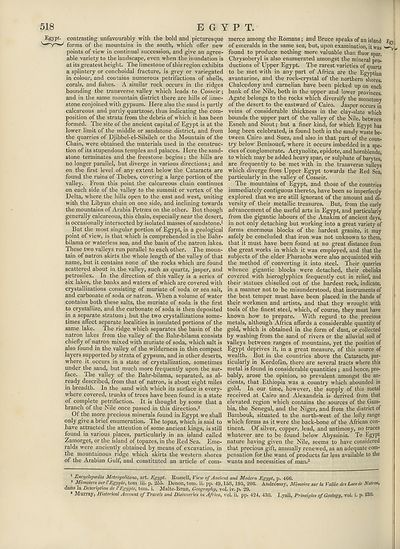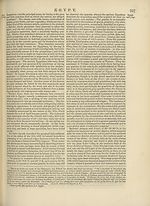Encyclopaedia Britannica > Volume 8, DIA-England
(528) Page 518
Download files
Complete book:
Individual page:
Thumbnail gallery: Grid view | List view

EGYPT.
518
EgJ'P1* contrasting unfavourably with the bold and picturesque
V—forms of the mountains in the south, which offer new
points of view in continual succession, and give an agree¬
able variety to the landscape, even when the inundation is
at its greatest height. The limestone of this region exhibits
a splintery or conchoidal fracture, is grey or variegated
in colour, and contains numerous petrifactions of shells,
corals, and fishes. A similar rock occurs in the ridges
bounding the transverse valley which leads to Cosseir;
and in the same mountain district there are hills of lime¬
stone conjoined with gypsum. Here also the sand is partly
calcareous and partly quartzose, thus indicating the com¬
position of the strata from the debris of which it has been
formed. The site of the ancient capital of Egypt is at the
lower limit of the middle or sandstone district, and from
the quarries of Djibbel-el-Silsileh or the Mountain of the
Chain, were obtained the materials used in the construc¬
tion of its stupendous temples and palaces. Here the sand¬
stone terminates and the freestone begins; the hills are
no longer parallel, but diverge in various directions; and
on the first level of any extent below the Cataracts are
found the ruins of Thebes, covering a large portion of the
valley. From this point the calcareous chain continues
on each side of the valley to the summit or vertex of the
Delta, where the hills open to the east and west, uniting
with the Libyan chain on one side, and inclining towards
the mountains of Arabia Petraea on the other. But though
generally calcareous, this chain, especially near the desert,
is occasionally intersected by isolated masses of sandstone.1
But the most singular portion of Egypt, in a geological
point of view, is that which is comprehended in the Bahr-
bilama or waterless sea, and the basin of the natron lakes.
These two valleys run parallel to each other. The moun¬
tain of natron skirts the whole length of the valley of that
name, but it contains none of the rocks which are found
scattered about in the valley, such as quartz, jasper, and
petrosilex. In the direction of this valley is a series of
six lakes, the banks and waters of which are covered with
crystallizations consisting of muriate of soda or sea salt,
and carbonate of soda or natron. When a volume of water
contains both these salts, the muriate of soda is the first
to crystallize, and the carbonate of soda is then deposited
in a separate stratum; but the two crystallizations some¬
times affect separate localities in insulated portions of the
same lake. The ridge which separates the basin of the
natron lakes from the valley of the Bahr-bilama consists
chiefly of natron mixed with muriate of soda, which salt is
also found in the valley of the wilderness in thin compact
layers supported by strata of gypsum, and in other deserts,
where it occurs in a state of crystallization, sometimes
under the sand, but much more frequently upon the sur¬
face. The valley of the Bahr-bilama, separated, as al¬
ready described, from that of natron, is about eight miles
in breadth. In the sand with which its surface is every¬
where covered, trunks of trees have been found in a state
of complete petrifaction. It is thought by some that a
branch of the Nile once passed in this direction.2
Of the more precious minerals found in Egypt we shall
only give a brief enumeration. The topaz, which is said to
have attracted the attention of some ancient kings, is still
found in various places, particularly in an island called
Zamorget, or the island of topazes, in the Red Sea. Eme¬
ralds were anciently obtained by means of excavation, in
the mountainous ridge which skirts the western shores
of the Arabian Gulf, and constituted an article of com¬
merce among the Romans; and Bruce speaks of an island F,™
of emeralds in the same sea, but, upon examination, it was
found to produce nothing more valuable than fluor spar.
Chrysoberyl is also enumerated amongst the mineral pro¬
ductions of Upper Egypt. The rarest varieties of quartz
to be met with in any part of Africa are the Egyptian
avanturine, and the rock-crystal of the northern shores.
Chalcedony and carnelian have been picked up on each
bank of the Nile, both in the upper and lower provinces.
Agate belongs to the rocks which diversify the monotony
of the desert to the eastward of Cairo. Jasper occurs in
veins of considerable thickness in the clay-slate which
bounds the upper part of the valley of the Nile, between
Esneh and Siout; but a finer kind, for which Egypt has
long been celebrated, is found both in the sandy waste be¬
tween Cairo and Suez, and also in that part of the coun¬
try below Benisouef, where it occurs imbedded in a spe¬
cies of conglomerate. Actynolite, epidote, and hornblende,
to which may be added heavy spar, or sulphate of barytes,
are frequently to be met with in the transverse valleys
which diverge from Upper Egypt towards the Red Sea,
particularly in the valley of Cosseir.
The mountains of Egypt, and those of the countries
immediately contiguous thereto, have been so imperfectly
explored that we are still ignorant of the amount and di¬
versity of their metallic treasures. But, from the early
advancement of the useful arts in Egypt, and particularly
from the gigantic labours of the Anakim of ancient days,
in not only detaching but working into a great variety of
forms enormous blocks of the hardest granite, it may
safely be concluded that iron was not unknown to them,
that it must have been found at no great distance from
the great works in which it was employed, and that the
subjects of the elder Pharaohs were also acquainted with
the method of converting it into steel. Their quarries
whence gigantic blocks were detached, their obelisks
covered with hieroglyphics frequently cut in relief, and
their statues chiselled out of the hardest rock, indicate,
in a manner not to be misunderstood, that instruments of
the best temper must have been placed in the hands of
their workmen and artists, and that they wrought with
tools of the finest steel, which, of course, they must have
known how to prepare. With regard to the precious
metals, although Africa affords a considerable quantity of
gold, which is obtained in the form of dust, or collected
by washing from the sand of rivers or the alluvial soil of
valleys between ranges of mountains, yet the position of
Egypt deprives it, in a great measure, of this source of
wealth. But in the countries above the Cataracts, par¬
ticularly in Kordofan, there are several tracts where this
metal is found in considerable quantities ; and hence, pro¬
bably, arose the opinion, so prevalent amongst the an¬
cients, that Ethiopia was a country which abounded in
gold. In our time, however, the supply of this metal
received at Cairo and Alexandria is derived from that
elevated region which contains the sources of the Gam¬
bia, the Senegal, and the Niger, and from the district of
Bambouk, situated to the north-west of the lofty range
which forms as it were the back-bone of the African con¬
tinent. Of silver, copper, lead, and antimony, no traces
whatever are to be found below Abyssinia. To Egypt
nature having given the Nile, seems to have considered
that precious gift, annually renewed, as an adequate com¬
pensation for the want of products far less available to the
wants and necessities of man.3
1 Encyclopaedia Metropolitana, art. Egypt. Russell, View of Ancient and Modern Egypt, p. 466.
2 Memoires sur VEgypte, tom ill. p. 255. Denon, tom. ii. pp. 49, 158, 195, 208. Andreossy, Mtmoire sur la Vallee desLacsdc Natron,
dans la Description de VEgypte, tom. i. Malte-Rrun, Geography, vol. iv. p. 29.
* Murray, Historical Account of Travels and Discoveries in Africa, vol. ii. pp. 424, 438. Lyall, Principles of Geology, vol. i. p- 238.
518
EgJ'P1* contrasting unfavourably with the bold and picturesque
V—forms of the mountains in the south, which offer new
points of view in continual succession, and give an agree¬
able variety to the landscape, even when the inundation is
at its greatest height. The limestone of this region exhibits
a splintery or conchoidal fracture, is grey or variegated
in colour, and contains numerous petrifactions of shells,
corals, and fishes. A similar rock occurs in the ridges
bounding the transverse valley which leads to Cosseir;
and in the same mountain district there are hills of lime¬
stone conjoined with gypsum. Here also the sand is partly
calcareous and partly quartzose, thus indicating the com¬
position of the strata from the debris of which it has been
formed. The site of the ancient capital of Egypt is at the
lower limit of the middle or sandstone district, and from
the quarries of Djibbel-el-Silsileh or the Mountain of the
Chain, were obtained the materials used in the construc¬
tion of its stupendous temples and palaces. Here the sand¬
stone terminates and the freestone begins; the hills are
no longer parallel, but diverge in various directions; and
on the first level of any extent below the Cataracts are
found the ruins of Thebes, covering a large portion of the
valley. From this point the calcareous chain continues
on each side of the valley to the summit or vertex of the
Delta, where the hills open to the east and west, uniting
with the Libyan chain on one side, and inclining towards
the mountains of Arabia Petraea on the other. But though
generally calcareous, this chain, especially near the desert,
is occasionally intersected by isolated masses of sandstone.1
But the most singular portion of Egypt, in a geological
point of view, is that which is comprehended in the Bahr-
bilama or waterless sea, and the basin of the natron lakes.
These two valleys run parallel to each other. The moun¬
tain of natron skirts the whole length of the valley of that
name, but it contains none of the rocks which are found
scattered about in the valley, such as quartz, jasper, and
petrosilex. In the direction of this valley is a series of
six lakes, the banks and waters of which are covered with
crystallizations consisting of muriate of soda or sea salt,
and carbonate of soda or natron. When a volume of water
contains both these salts, the muriate of soda is the first
to crystallize, and the carbonate of soda is then deposited
in a separate stratum; but the two crystallizations some¬
times affect separate localities in insulated portions of the
same lake. The ridge which separates the basin of the
natron lakes from the valley of the Bahr-bilama consists
chiefly of natron mixed with muriate of soda, which salt is
also found in the valley of the wilderness in thin compact
layers supported by strata of gypsum, and in other deserts,
where it occurs in a state of crystallization, sometimes
under the sand, but much more frequently upon the sur¬
face. The valley of the Bahr-bilama, separated, as al¬
ready described, from that of natron, is about eight miles
in breadth. In the sand with which its surface is every¬
where covered, trunks of trees have been found in a state
of complete petrifaction. It is thought by some that a
branch of the Nile once passed in this direction.2
Of the more precious minerals found in Egypt we shall
only give a brief enumeration. The topaz, which is said to
have attracted the attention of some ancient kings, is still
found in various places, particularly in an island called
Zamorget, or the island of topazes, in the Red Sea. Eme¬
ralds were anciently obtained by means of excavation, in
the mountainous ridge which skirts the western shores
of the Arabian Gulf, and constituted an article of com¬
merce among the Romans; and Bruce speaks of an island F,™
of emeralds in the same sea, but, upon examination, it was
found to produce nothing more valuable than fluor spar.
Chrysoberyl is also enumerated amongst the mineral pro¬
ductions of Upper Egypt. The rarest varieties of quartz
to be met with in any part of Africa are the Egyptian
avanturine, and the rock-crystal of the northern shores.
Chalcedony and carnelian have been picked up on each
bank of the Nile, both in the upper and lower provinces.
Agate belongs to the rocks which diversify the monotony
of the desert to the eastward of Cairo. Jasper occurs in
veins of considerable thickness in the clay-slate which
bounds the upper part of the valley of the Nile, between
Esneh and Siout; but a finer kind, for which Egypt has
long been celebrated, is found both in the sandy waste be¬
tween Cairo and Suez, and also in that part of the coun¬
try below Benisouef, where it occurs imbedded in a spe¬
cies of conglomerate. Actynolite, epidote, and hornblende,
to which may be added heavy spar, or sulphate of barytes,
are frequently to be met with in the transverse valleys
which diverge from Upper Egypt towards the Red Sea,
particularly in the valley of Cosseir.
The mountains of Egypt, and those of the countries
immediately contiguous thereto, have been so imperfectly
explored that we are still ignorant of the amount and di¬
versity of their metallic treasures. But, from the early
advancement of the useful arts in Egypt, and particularly
from the gigantic labours of the Anakim of ancient days,
in not only detaching but working into a great variety of
forms enormous blocks of the hardest granite, it may
safely be concluded that iron was not unknown to them,
that it must have been found at no great distance from
the great works in which it was employed, and that the
subjects of the elder Pharaohs were also acquainted with
the method of converting it into steel. Their quarries
whence gigantic blocks were detached, their obelisks
covered with hieroglyphics frequently cut in relief, and
their statues chiselled out of the hardest rock, indicate,
in a manner not to be misunderstood, that instruments of
the best temper must have been placed in the hands of
their workmen and artists, and that they wrought with
tools of the finest steel, which, of course, they must have
known how to prepare. With regard to the precious
metals, although Africa affords a considerable quantity of
gold, which is obtained in the form of dust, or collected
by washing from the sand of rivers or the alluvial soil of
valleys between ranges of mountains, yet the position of
Egypt deprives it, in a great measure, of this source of
wealth. But in the countries above the Cataracts, par¬
ticularly in Kordofan, there are several tracts where this
metal is found in considerable quantities ; and hence, pro¬
bably, arose the opinion, so prevalent amongst the an¬
cients, that Ethiopia was a country which abounded in
gold. In our time, however, the supply of this metal
received at Cairo and Alexandria is derived from that
elevated region which contains the sources of the Gam¬
bia, the Senegal, and the Niger, and from the district of
Bambouk, situated to the north-west of the lofty range
which forms as it were the back-bone of the African con¬
tinent. Of silver, copper, lead, and antimony, no traces
whatever are to be found below Abyssinia. To Egypt
nature having given the Nile, seems to have considered
that precious gift, annually renewed, as an adequate com¬
pensation for the want of products far less available to the
wants and necessities of man.3
1 Encyclopaedia Metropolitana, art. Egypt. Russell, View of Ancient and Modern Egypt, p. 466.
2 Memoires sur VEgypte, tom ill. p. 255. Denon, tom. ii. pp. 49, 158, 195, 208. Andreossy, Mtmoire sur la Vallee desLacsdc Natron,
dans la Description de VEgypte, tom. i. Malte-Rrun, Geography, vol. iv. p. 29.
* Murray, Historical Account of Travels and Discoveries in Africa, vol. ii. pp. 424, 438. Lyall, Principles of Geology, vol. i. p- 238.
Set display mode to:
![]() Universal Viewer |
Universal Viewer | ![]() Mirador |
Large image | Transcription
Mirador |
Large image | Transcription
Images and transcriptions on this page, including medium image downloads, may be used under the Creative Commons Attribution 4.0 International Licence unless otherwise stated. ![]()
| Encyclopaedia Britannica > Encyclopaedia Britannica > Volume 8, DIA-England > (528) Page 518 |
|---|
| Permanent URL | https://digital.nls.uk/193329869 |
|---|
| Attribution and copyright: |
|
|---|
| Description | Ten editions of 'Encyclopaedia Britannica', issued from 1768-1903, in 231 volumes. Originally issued in 100 weekly parts (3 volumes) between 1768 and 1771 by publishers: Colin Macfarquhar and Andrew Bell (Edinburgh); editor: William Smellie: engraver: Andrew Bell. Expanded editions in the 19th century featured more volumes and contributions from leading experts in their fields. Managed and published in Edinburgh up to the 9th edition (25 volumes, from 1875-1889); the 10th edition (1902-1903) re-issued the 9th edition, with 11 supplementary volumes. |
|---|---|
| Additional NLS resources: |
|

